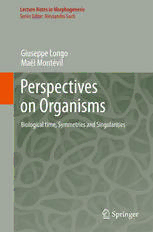
Perspectives on Organisms: Biological time, Symmetries and Singularities PDF
Preview Perspectives on Organisms: Biological time, Symmetries and Singularities
Lecture Notes in Morphogenesis Series Editor: Alessandro Sarti Giuseppe Longo Maël Montévil Perspectives on Organisms Biological Time, Symmetries and Singularities Lecture Notes in Morphogenesis Serieseditor AlessandroSarti,CREA/CNRS,Paris,France e-mail:[email protected] Forfurthervolumes: http://www.springer.com/series/11247 · Giuseppe Longo Maël Montévil Perspectives on Organisms Biological Time, Symmetries and Singularities ABC GiuseppeLongo MaëlMontévil CentreInterdisciplinaireCavaillès AnatomyandCellBiology (CIRPHLES) TuftUniversity CNRSandEcoleNormaleSupérieure Boston Paris USA France ISSN2195-1934 ISSN2195-1942 (electronic) ISBN978-3-642-35937-8 ISBN978-3-642-35938-5 (eBook) DOI10.1007/978-3-642-35938-5 SpringerHeidelbergNewYorkDordrechtLondon LibraryofCongressControlNumber:2013954680 (cid:2)c Springer-VerlagBerlinHeidelberg2014 Thisworkissubjecttocopyright.AllrightsarereservedbythePublisher,whetherthewholeorpartof thematerialisconcerned,specificallytherightsoftranslation,reprinting,reuseofillustrations,recitation, broadcasting,reproductiononmicrofilmsorinanyotherphysicalway,andtransmissionorinformation storageandretrieval,electronicadaptation,computersoftware,orbysimilarordissimilarmethodology nowknownorhereafterdeveloped.Exemptedfromthislegalreservationarebriefexcerptsinconnection with reviews or scholarly analysis or material supplied specifically for the purpose of being entered and executed on a computer system, for exclusive use by the purchaser of the work. Duplication of this publication or parts thereof is permitted only under the provisions of the Copyright Law of the Publisher’slocation,initscurrentversion,andpermissionforusemustalwaysbeobtainedfromSpringer. PermissionsforusemaybeobtainedthroughRightsLinkattheCopyrightClearanceCenter.Violations areliabletoprosecutionundertherespectiveCopyrightLaw. Theuseofgeneraldescriptivenames,registerednames,trademarks,servicemarks,etc.inthispublication doesnotimply,evenintheabsenceofaspecificstatement,thatsuchnamesareexemptfromtherelevant protectivelawsandregulationsandthereforefreeforgeneraluse. Whiletheadviceandinformationinthisbookarebelievedtobetrueandaccurateatthedateofpub- lication,neithertheauthorsnortheeditorsnorthepublishercanacceptanylegalresponsibilityforany errorsoromissionsthatmaybemade.Thepublishermakesnowarranty,expressorimplied,withrespect tothematerialcontainedherein. Printedonacid-freepaper SpringerispartofSpringerScience+BusinessMedia(www.springer.com) To FrancisBailly, for hishumanismin science, hisdiscreet enthusiasm,hisopennessto others’ideas whilestayingfirm inhisprinciples,his drivencommitmentto understandthe thinkingof others,histrustinggenerosityin thecommonendeavourto knowledge, his criticalthinkingtailoredtobetter advance beyond themainstream. Foreword byDenisNoble During most of the twentieth century experimental and theoretical biologists livedseparatelives.Astheauthorsofthisbookexpressit,“therewasabeliefthat experimentaland theoreticalthinkingcouldbe decoupled.”Thiswas a strange di- vorce.Noothersciencehasexperiencedsuchaseparation.Itisinconceivablethat physical experiments could be done without extensive mathematical theory being used to give quantitative and conceptual expression to the ideas that motivate the questionsthatexperimentaliststrytoanswer.Itwouldbeimpossibleforthephysi- cistsatthelargehadroncollider,forexample,tosearchforwhatwecalltheHiggs boson without the theoretical backgroundthat can make sense of what the Higgs bosoncouldbe.Thegiganticmassesofdatathatcomeoutofsuchexperimentation would be an un-interpretablemass without the theory. Similarly, modern cosmol- ogyandtheinterpretationofthehugeamountsofdataobtainedthroughnewforms oftelescopeswouldbeinconceivablewithoutthetheoreticalstructureprovidedby Einstein’sgeneraltheoryofrelativity.Thephenomenonofgravitationallensing,for example, would be impossible to understand or even to discover. The physics of thesmallestscalesoftheuniversewouldalsobeimpossibletomanagewithoutthe theoreticalstructureofquantummechanics. So,howdidexperimentalbiologyapparentlymanageforsomanyyearswithout suchtheoreticalstructures?Actually,itdidn’t.Thedivorcewasonlyapparent. First,therewasageneraltheoreticalstructureprovidedbyevolutionarybiology. Very little in biology makes much sense without the theory of evolution. But this theorydoesnotmakespecific predictionsin the way in whichtheHiggsbosonor gravitational lensing were predicted for physicists. The idea of evolution is more thatofageneralframeworkwithinwhichbiologyisinterpreted. Second, there was theory in biology. In fact there were many theories, and in many different forms. Moreover, these theories were used by experimentalbiolo- gists.Theyweretheideasinthemindsofexperimentalbiologists.Nosciencecan be done without theoretical constructs. The so-called Central Dogma of Molecu- lar Biology, for example, was an expressionof the backgroundof ideas that were VIII Foreword circulatingduringthe early heydaysof molecularbiology:thatcausation was one way (genesto phenotypes),and thatinheritancewas entirelyattributable to DNA, bywhichanorganismcouldbecompletelydefined.Thiswasatheory,exceptthat itwasnotformulatedassuch.Itwaspresentedasfact,afaitaccompli.Meanwhile thepagesofjournalsoftheoreticalandmathematicalbiologycontinuedtobefilled with fascinating and difficultpapers to which experimentalists, by and large, paid littleornoattention. Wecancallthetheoriesthatexperimentalistshadinmindimplicittheories.Often theywerenotevenrecognisedastheory.WhenRichardDawkinswrotehispersua- sive book The Selfish Gene in 1976 he was not only giving expression to many oftheseimplicittheories,healsomisinterpretedthemthroughfailingtounderstand theroleofmetaphorinbiology.Indeed,heoriginallystated“thatwasnometaphor”! AsPoincare´ pointedoutin hislovelybookScienceandHypothesis(Lascience et l’hypothe`se)theworstmistakesinsciencearemadebythosewhoproudlyproclaim thattheyarenotphilosophers,asthoughphilosophyhadalreadycompleteditstask andhadbeencompletelyreplacedbyempiricalscience.Thetruthisverydifferent. Theadvanceofscienceitselfcreatesnewphilosophicalquestions.Thosewhotackle suchquestionsare philosophers,evenif theydonotacknowledgethatname.That isparticularlytrueofthekindoftheorythatcouldbedescribedasmeta-theory:the creationoftheframeworkwithinwhichnewtheorycanbedeveloped.Iseecreating thatframeworkasoneofthechallengestowhichthisbookresponds. Justasphysicistswouldnotknowwhattodowiththegiganticdatapouringout oftheircollidersandtelescopeswithoutastructureofinterpretativetheory,biology has hitup againstexactlythe same problem.We also are now generatinggigantic amounts of genomic, proteomic, metabolomic and physiomic data. We are swim- mingindata.Theproblemisthatthetheoreticalstructureswithinwhichtointerpret itareunderdevelopedorhavebeenignoredandforgotten.Thecracksareappearing everywhere.Eventhe centraltheoryofbiology,evolution,is undergoingreassess- ment in the light of discoveriesshowing that what the modern synthesis said was impossible,suchastheinheritanceofacquiredcharacters,doesinfactoccur.There isanessentialincompletenessinbiologicaltheorythatcallsouttobefilled. That brings me to the question how to characterise this book. It is ambitious. Itaimsatnothinglessthanfillingthatgap.Itopenlyaimsatbringingtherigourof theoryinphysicstobearontheroleoftheoryinbiology.Itisahighlywelcomechal- lengetotheoristsandexperimentalistsalike.Mybeliefisthat,asweprogressively makesenseofthemassesofexperimentaldatawewillfindourselvesdevelopingthe conceptualfoundationsof biologyin rigorousmathematicalforms.One day(who knows when?), biology will become more like physics in this respect: theory and experimentalworkwillbeinextricablyintertwined. However, it is important that readers should appreciate that such intertwining doesnotmeanthatbiologybecomes,orcouldbe,reducibletophysics.Astheau- thorssay,evenifwewantedsuchareduction,towhatphysicsshouldthereduction occur?Physics is nota static structure from which biologistscan, as it were, take things ‘off the shelf’. Physics has undergonerevolutionarychange during the last centuryorso.Thereisnosignthatweareattheendofthisprocess.Norwoulditbe Foreword IX safetoassumethat,evenifitdidseemtobetrue.Itseemedtruetoearlyandmid- nineteenthcenturybiologists,suchasJean-BaptisteLamarck,ClaudeBernard,and manyothers.Theycouldassume,withLaplace,thatthefundamentallawsofnature werestrictlydeterministic.Today,weknowboththatthefundamentallawsdonot workinthatway,andthatstochasticityisalsoimportantinbiology.Thelessonof thehistoryofscienceisthatsurprisesturnupjustwhenwethinkwehaveachieved orareapproachingcompleteness. Theclaimmadeinthisbookisthatthereisnocurrenttheoryofbiologicalorgan- isation.Theauthorsalsoexplainthereasonforthat.Itliesinthemulti-levelnature of biological interactions, with lower level molecular processes just as dependent on higher-levelorganisationand processes, as they in their turn are dependenton themolecularprocesses.Theerroroftwentiethcenturybiologywastoassumefar tooreadilythatcausationisone-way.Astheauthorssay,“themolecularleveldoes notaccommodatephenomenathatoccurtypicallyatotherlevelsoforganisation.”I encounteredthisinsightin1960whenIwasinterpretingexperimentaldataoncar- diacpotassiumchannelsusingmathematicalmodellingtoreconstructheartrhythm. The rhythmsimply does notexist at the molecularlevel. The processoccursonly when the molecules are constrainedby the whole cardiac cell to be controlled by causationrunningintheoppositedirection:fromthecelltothemolecularcompo- nents. This insight is general. Of course, cells form an extremely important level oforganisation,withoutwhichorganismswithtissues,organsandwhole-bodysys- temswouldbeimpossible.Buttheotherlevelsarealsoimportantintheirownways. Ultimately,eventheenvironmentcaninfluencegeneexpressionlevels.Thereisno apriorireasontoprivilegeanyonelevelincausation.Thisistheprincipleofbio- logicalrelativity. Theprincipledoesnotmeanthatthevariouslevelsareinanysenseequivalent.To quotetheauthorsagain:“InnowaydowemeantonegatethatDNAandthemolec- ular cascades that are related to it, play an important role, yet their investigations arefarfromcompleteregardingthedescriptionoflifephenomena.”Completeness isthekeyconcept.Thatistrueforbiologicalinheritanceaswellasforphenotype- genotyperelations.Newexperimentalworkisrevealingthatthereismuchmoreto inheritancethanDNA. Theavoidanceofengagementwiththeoreticalworkinbiologywasbasedlargely ontheassumptionthatanalysisatthemolecularlevelcouldbe,andwasinprinciple, complete.Incontrast,the authroswrite,“these[molecular]cascadesmaycausally dependonactivitiesatdifferentlevelsofanalysis,whichinteractwiththemandalso deserveproperinsights.”Those‘properinsights’mustbeginbyidentifyingtheenti- tiesandprocessesthatcanbesaidtoexistatthehigherlevels:“findingwaystocon- stitute theoreticallybiologicalobjectsand objectivise their behaviour.”To achieve thiswehavetodistanceourselvesfromthenotion,prevalentinbiologytoday,that the fundamental must be conceptually elementary. As the authors point out, this is not even true in physics. “Moreover, the proper elementary observable doesn’t need to be “simple”. “Elementary particles” are not conceptually/mathematically simple.” X Foreword There is therefore a need for a general theory of biological objects and their dynamics.Thisbookisamajorstepinachievingthataim.Itpointsthewaytosome of the importantprinciples,such as the principleof symmetry,thatmust formthe basisofsuchatheory.Italsotreatsbiologicaltimeinaninnovativeway,itexplores theconceptofextendedcriticalityanditintroducestheideaofanti-entropy.Ifthese terms are unfamiliar to you, this book will explain them and why they help us to conceptualize the results of experimental biology. They in turn will lead the way bywhichexperimentalistscanidentifyandcharacterizethenewbiologicalobjects aroundwhichafullytheoreticalbiologycouldbeconstructed. OxfordUniversity, DenisNoble June2013 Preface In this book,we proposeoriginalperspectivesin theoreticalbiology.We referex- tensivelytophysicalmethodsofunderstandingphenomenabutin anuntraditional manner.Attimes,wedirectlyemploymethodsfromphysics,butmoreimportantly, weradicallycontrastphysicalwaysofconstructingknowledgewithwhat,weclaim, isrequiredforconceptualconstructionsinbiology. One of the difficult aspects of biology, especially with respect to physical in- sights,istheunderstandingoforganismsandbyextensiontheimplicationsofwhat it means for an object of knowledgeto be a part of an organism.The question of whichconceptualandtechnicalframeworksareneededtoachievethisunderstand- ing is remarkably open. One such framework we propose is extended criticality. Extended criticality, one of our main themes, ties together the structure of coher- encethatformsanorganismandthevariabilityandhistoricitythatcharacterizeit. Wealsonotethatthisframeworkisnotmeanttobepertinentinunderstandingthe inert. We are aware that our theoretical proposals are of a kind of abstraction that is unfamiliarto mostbiologists.An epistemologicalremarkcan hopefullymake this kindofabstractthinkinglessunearthly.Atthecoreofmathematicalabstractions,not unlike in biologicalexperiments,lies the “gesture”made by the scientist. By ges- turewemeanbodilymovements,realorimagined,suchasrearrangingasequence ofnumbersintheabstractorseedingthesamenumberofcellsoverseveralwells. Gesturesmayremainmostlyvirtualinmathematics,yetanymathematicalproofis basicallyaseriesofacceptablegesturesmadebythemathematician—boththeones describedbyagivenformalismandtheonesperformedatthelevelofmorefunda- mentalintuitions(which motivatethe formalismsthemselves). For example,sym- metriesrefertoapplyingtransformations(e.g.rotating)andorderreferstosorting (eg:thewell-orderingofintegernumbersandtheorderingoforientedtime),bothof whicharegestures.SinceGreekgeometryuntilcontemporaryphysics,symmetries (defininginvariance)andorder(asforoptimality)havejointlylaidthefoundationof mathematicsandtheoreticalphysicswithinthehumanspacesofactionandknowl- edge.Insummary,thetheoreticiansinglesoutconceptualcontoursandorganizesthe Worldsimilarlyastheexperimenterpreparesandexecutesscientificexperiments.
